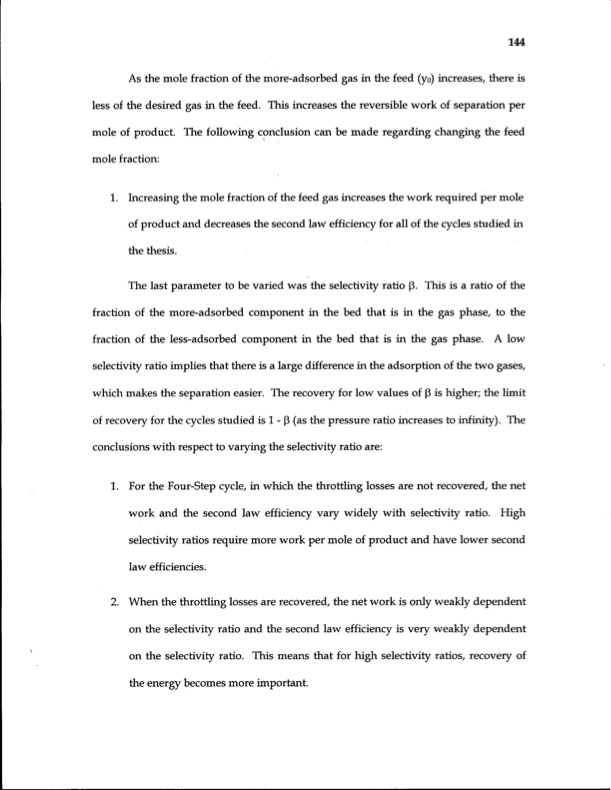
PDF Publication Title:
Text from PDF Page: 160
As the mole fraction of the more-adsorbed gas in the feed (yo) increases, there is less of the desired gas in the feed. This increases the reversible work of separation per mole of product. The following conclusion can be made regarding changing the feed mole fraction: 1. Increasing the mole fraction of the feed gas increases the work required per mole of product and decreases the second law efficiency for all of the cycles studied in the thesis. The last parameter to be varied was the selectivity ratio p. This is a ratio of the fraction of the more-adsorbed component in the bed that is in the gas phase, to the fraction of the less-adsorbed component in the bed that is in the gas phase. A low selectivity ratio implies that there is a large difference in the adsorption of the two gases, which makes the separation easier. The recovery for low values of p is higher; the limit of recovery for the cycles studied is 1 - P (as the pressure ratio increases to infinity). The conclusions with respect to varying the selectivity ratio are: 1. For the Four-Step cycle, in which the throttling losses are not recovered, the net work and the second law efficiency vary widely with selectivity ratio. High selectivity ratios require more work per mole of product and have lower second law efficiencies. 2. When the mrottling losses are recovered, the net work is only weakly dependent on the selectivity ratio and the second law efficiency is very weakly dependent on the selectivity ratio. This means that for high selectivity ratios, recovery of the energy becomes more important. 144PDF Image | Energy Efficiency of Gas Separation Pressure Swing Adsorption

PDF Search Title:
Energy Efficiency of Gas Separation Pressure Swing AdsorptionOriginal File Name Searched:
ubc_1997-0009.pdfDIY PDF Search: Google It | Yahoo | Bing
CO2 Organic Rankine Cycle Experimenter Platform The supercritical CO2 phase change system is both a heat pump and organic rankine cycle which can be used for those purposes and as a supercritical extractor for advanced subcritical and supercritical extraction technology. Uses include producing nanoparticles, precious metal CO2 extraction, lithium battery recycling, and other applications... More Info
Heat Pumps CO2 ORC Heat Pump System Platform More Info
| CONTACT TEL: 608-238-6001 Email: greg@infinityturbine.com | RSS | AMP |